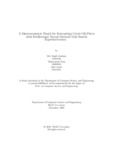| dc.contributor.advisor | Majumdar, Mahbubul Alam | |
| dc.contributor.author | Aunjum, Md. Ragib | |
| dc.contributor.author | Naqi, Muhammad | |
| dc.contributor.author | Jamil, Sifat | |
| dc.date.accessioned | 2021-07-07T06:28:29Z | |
| dc.date.available | 2021-07-07T06:28:29Z | |
| dc.date.copyright | 2019 | |
| dc.date.issued | 2019-12 | |
| dc.identifier.other | ID: 16301096 | |
| dc.identifier.other | ID: 16301083 | |
| dc.identifier.other | ID: 19341029 | |
| dc.identifier.uri | http://hdl.handle.net/10361/14750 | |
| dc.description | This thesis is submitted in partial fulfillment of the requirements for the degree of Bachelor of Science in Computer Science and Engineering, 2019. | en_US |
| dc.description | Cataloged from PDF version of thesis. | |
| dc.description | Includes bibliographical references (pages 56-58). | |
| dc.description.abstract | Crude oil is one of the most important determinant of the global and national economy and important decision making factors of industrial activities. For this reason,
numerous mathematical and machine learning approaches have been conducted to
predict the future trend of oil market. Yet, to predict the price of oil is one of the
most challenging issues out there because the high volatile nature of oil market and
the dependency of price on other factors. In many approaches on predicting oil price
use machine learning algorithms, the only factors considered are the opening and
closing prices. Thus, the implementations did not reflect the price pattern truly and
also hampered the sudden ups and downs of price because the oil market does not
only depend on the daily pricing behavior. By reviewing the historical data of oil
market it can clearly be seen that the oil market is heavily affected by the geopolitical, technical and macroeconomic factors. For example, geopolitical factor such
as war in middle east made the oil price soared high and broke the pattern of daily
fluctuations by a large margin. And also, it can easily be seen that the everyday
demand of oil along with the quantity supplied affects the oil market. So, these
factors along with other macroeconomic and technical issues must be addressed to
successfully determine the oil price trend. To justify our claim, we approach to predict the oil price using only the opening and closing market price by ARIMA, SVR
and Linear regression model. Afterwards, the macroeconomic, technical, geopolitical factors were considered to predict oil price using Feed Forward Neural Network
and compared the results with the ones we have found on the previous models. | en_US |
| dc.description.statementofresponsibility | Md. Ragib Aunjum | |
| dc.description.statementofresponsibility | Muhammad Naqi | |
| dc.description.statementofresponsibility | Sifat Jamil | |
| dc.format.extent | 58 Pages | |
| dc.language.iso | en_US | en_US |
| dc.publisher | Brac University | en_US |
| dc.rights | Brac University theses are protected by copyright. They may be viewed from this source for any purpose, but reproduction or distribution in any format is prohibited without written permission. | |
| dc.subject | Crude oil price prediction | en_US |
| dc.subject | Machine Learning | en_US |
| dc.subject | Technical Factors | en_US |
| dc.subject | Macroeconomic Factors | en_US |
| dc.subject | Geopolitical Factors | en_US |
| dc.subject | ARIMA | en_US |
| dc.subject | Artificial Neural Network | en_US |
| dc.subject | Grid search | en_US |
| dc.title | A macroeconomic model for forecasting crude oil prices with Feedforward Neural Network Grid Search Experimentation | en_US |
| dc.type | Thesis | en_US |
| dc.contributor.department | Department of Computer Science and Engineering, Brac University | |
| dc.description.degree | B. Computer Science | |

